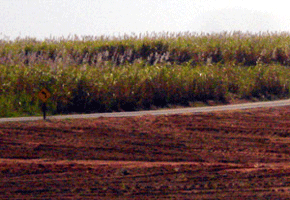

Study will make it possible to identify areas with more microorganisms that help sugarcane develop better or resist disease
Study will make it possible to identify areas with more microorganisms that help sugarcane develop better or resist disease
Study will make it possible to identify areas with more microorganisms that help sugarcane develop better or resist disease

Study will make it possible to identify areas with more microorganisms that help sugarcane develop better or resist disease
By Elton Alisson
Agência FAPESP – Currently, physical and climatic maps of São Paulo State are available that show the regions that are most environmentally favorable for raising sugarcane, the state’s most important crop. However, there is still no microbiological map that shows, for example, the areas with the best soil microbial composition for raising sugarcane.
A research project performed by researchers at the Universidade de São Paulo (USP) Luiz de Queiroz Graduate School of Agriculture (Esalq), with funding through FAPESP’s Bioenergy Research Program (BIOEN), intends to map the microbial diversity of the soil where sugarcane is cultivated in São Paulo.
The project results were presented during the NWO-FAPESP-CNPq Joint Workshop for Developing Research Collaborations held at FAPESP headquarters in São Paulo in June. Promoted by FAPESP, together with the National Council of Scientific and Technological Development (CNPq) and the Netherlands Organization for Scientific Research (NWO), the event sought to bolster collaboration between scientists in Brazil and the Netherlands on cooperative research projects related to bioeconomy on topics such as the resilience of agricultural production systems. The Esalq project falls directly in this category.
Initiated in 2011, the study’s objective is to map the groups of microorganisms in the soil where sugarcane is cultivated in São Paulo, correlating the results with factors such as the type of farming, climatic factors (for example, humidity and temperature), and the type of soil.
Based on the microbiological data obtained, it will be possible to estimate whether a certain region is richer in certain groups of microorganisms and therefore needs smaller amounts of fertilizers.
Another question that will be answered is the possible role of sugarcane leaves left on the fields after harvest in inducing the growth of certain groups of microorganisms in the soil. These microorganisms aid in the development of the plants by supplying them with nutrients or by making them more resistant to pests and disease.
“The study’s main idea is to be able to, based on knowledge of the soil’s microbiology, recommend types of management that induce the growth of certain microorganisms that help the plant nourish itself and grow, enhancing the natural resources of the area,” said Fernando Dini Andreote, Esalq professor and coordinator of the study, to Agência FAPESP.
According to Andreote, 15,000 to 30,000 species of microorganisms have been calculated to live in soils. The number of species varies according to factors such as the type of climate, the type of soil, the presence of forest, the presence of farming and land management.
To estimate which groups of microorganisms, including fungi, bacteria and others, occur in the sugarcane farming regions of São Paulo, researchers collected 440 specimens from 10 plots of land where sugarcane is farmed in 11 different regions of the state (ranging from the far north through the municipality of São Manoel, near Piracicaba). The study plots have varying temperatures, types of soil, and rainfall and are managed in many ways, ranging from mechanical harvesting to field burning.
The specimens were analyzed by the non-cultivation method, in which the DNA of all microorganisms present in the collected soil sample is extracted and sequenced to quantify the number of cells present for each group of organisms in the region. As many as 1 billion cells can be present in each gram of soil.
The physico-chemical analysis of the sample is not yet complete, but the first results for the evaluations of bacterial and fungal groups (which are further along) indicate that the groups vary depending on the area studied.
“We still haven’t done a statistical analysis that will allow us to state that a certain type of crop induces the growth of a certain group of bacteria or fungi. But we already know that a variety of groups of microorganisms occur in the regions analyzed, and we will check these findings to see whether they correspond to biological variation,” said Andreote.
The new method is much more reliable for quantifying microorganisms than the bacteria, fungus or archaea laboratory cultivation method, which manages to represent less than 1% of a micro-biome.
The researchers are completing their compilation of the data and carrying out statistical analyses of the samples to begin generating the first microbiological maps. They will try to detect possible spatial distributions of the groups of microorganisms on a macro or micro scale.
“Mapping will make it possible to carry out integrated analyses to determine the regions where sugarcane can be planted more actively in São Paulo,” predicted Andreote. Andreote said that when the mapping is complete, the microbiological maps of soils (which are likely to be made accessible online) will be able to be used for other crops and for other areas where sugarcane cultivation is developing, such as Mato Grosso and Goiás.
Republish
The Agency FAPESP licenses news via Creative Commons (CC-BY-NC-ND) so that they can be republished free of charge and in a simple way by other digital or printed vehicles. Agência FAPESP must be credited as the source of the content being republished and the name of the reporter (if any) must be attributed. Using the HMTL button below allows compliance with these rules, detailed in Digital Republishing Policy FAPESP.





